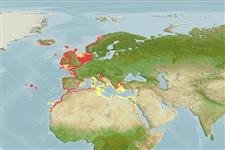Common names from other countries
Classification / Names / Names
Namen | Synonyme | Catalog of Fishes (gen., sp.) | ITIS | CoL | WoRMS
Environment: milieu / climate zone / depth range / distribution range
Ökologie
; tiefenbereich 0 - 83 m (Ref. 105051). Temperate; 69°N - 23°N, 45°W - 37°E
Northeast Atlantic, Mediterranean Sea and the Arctic: from Arctic Greenland to Norway, down to Morocco, to the Mediterranean . Subtropical to temperate.
Length at first maturity / Size / Gewicht / Alter
Maturity: Lm ? range ? - ? cm Max length : 20.0 cm TL Männchen/unbestimmt; (Ref. 126605); max. veröff. Gewicht: 130.00 g (Ref. 126605); max. veröff. Alter: 1.00 Jahre (Ref. 126605)
Maximum depth from Ref. 105342. Sea hares have annual life cycles (Ref. 126605). Found in infralittoral areas (Ref. 105324). Inhabits sublittoral beds of the red alga Plocamium coccineum where it also feeds on (Ref. 105169). Feeds on a variety of marine algae (Ref. 105170).
Life cycle and mating behavior
Geschlechtsreife | Fortpflanzung | Ablaichen | Eier | Fecundity | Larven
Simultaneous hermaphrodites (Ref. 833); aggregate mating (Ref. 106182).
Harms, J. 1993. (Ref. 2711)
IUCN Rote Liste Status (Ref. 130435)
CITES Status (Ref. 108899)
Not Evaluated
Not Evaluated
Bedrohung für Menschen
Harmless
Nutzung durch Menschen
Fischereien: kommerziell
| FishSource |
Tools
Mehr Information
Alter/GrößeWachstumLänge-GewichtLänge-LängeMorphologieLarvenDichte
Internet Quellen
Estimates based on models
Preferred temperature
(Ref.
115969): 8.4 - 18.1, mean 10.6 (based on 506 cells).
Preiskategorie
Unknown.
